A diode is a semiconductor device, typically made of silicon, that essentially acts as a one-way switch for current. It allows current to flow easily in one direction but severely restricts current from flowing in the opposite direction.
Diodes are also known as rectifiers because they change alternating current (AC) into pulsating direct current (DC). Diodes are rated according to their type, voltage, and current capacity.
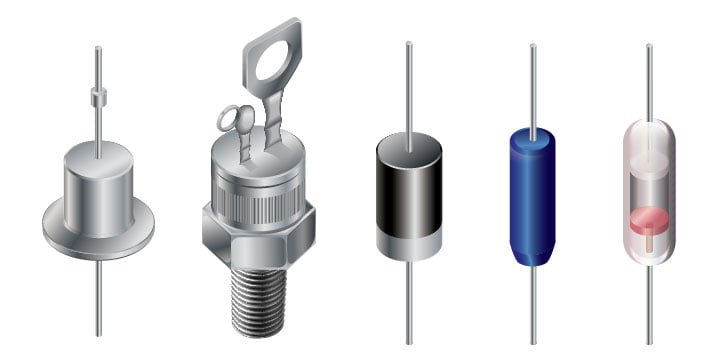
Diodes are available in various configurations. From left: metal case, stud mount, plastic case with band, plastic case with chamfer, glass case.
What Does a Diode Do?
Diodes have polarity, determined by an anode (positive lead) and cathode (negative lead). Most diodes allow current to flow only when positive voltage is applied to the anode.
When a diode allows current flow, it is forward-biased. When a diode is reverse-biased, it acts as an insulator and does not permit current to flow.
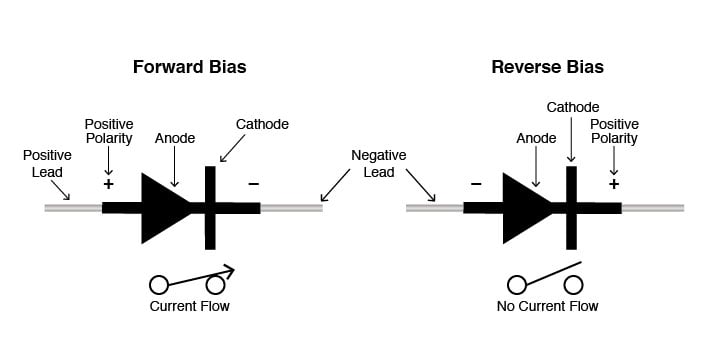
Strange but true: The diode symbol's arrow points against the direction of electron flow. The reason is that engineers conceived the symbol, and their schematics show current flowing from the positive (+) side of the voltage source to the negative (-). It's the same convention used for semiconductor symbols that include arrows — the arrow points in the permitted direction of "conventional" flow, and against the permitted direction of electron flow.
Types of Diodes
Different diode types all perform key functions in an electrical system. Here are some of the most important types of diodes.
- Rectifier Diodes: A rectifier diode converts AC into DC. Direct current flows in one consistent direction, making it easier to control.
- Zener Diodes: Zener diodes are designed to protect electrical systems from overvoltage. They conduct current in reverse whenever the cathode reaches a predetermined threshold voltage.
- Light Emitting Diodes: A light-emitting diode (LED) emits light when forward-biased current flows through it. LEDs are widely used in displays and indicators.
- Schottky Diodes: Schottky diodes, also known as barrier diodes or hot-carrier diodes, are often used in high-speed applications because of their fast-switching capabilities and their low forward voltage drop.
- Photodiodes: Photodiodes produce electrical currents when they absorb photons. They are widely used in sensors and in solar cells.
Diode Ratings and Testing
Every diode has a current and voltage rating, determined by factors like materials and design. Those ratings represent the maximum levels of voltage and currency the diode can tolerate.
Exceeding currency and voltage levels can cause permanent damage to the diode or to the whole circuit. High voltage levels may also cause the diode to short circuit and either allow current to flow in both directions or halt current from flowing in either direction.
Proper diode function can be tested with a digital multimeter (DMM).
Testing Diodes with a Digital Multimeter
There are two methods of testing diodes using a digital multimeter: diode test mode and resistance mode. Diode test mode is by far the more effective means of testing. Resistance testing is less reliable and should only be used if the multimeter does not have a diode test mode.
A digital multimeter's diode test produces a small voltage between the test leads, enough to forward-bias a diode junction. A good forward-bias diode displays a voltage drop from 0.5 to 0.8 volts (for most silicon diodes). The meter will display ‘OL’ when a good diode is reverse-biased. OL will indicate the diode is functioning as an open switch.
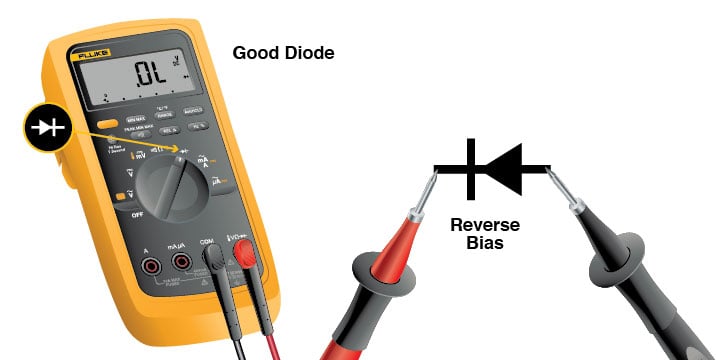
The forward-biased resistance of a good diode should range from 1000 ohms to 10 Mohms. Thereverse-biased resistance on a good diode, will read OL The diode is bad if readings are the same in both directions.
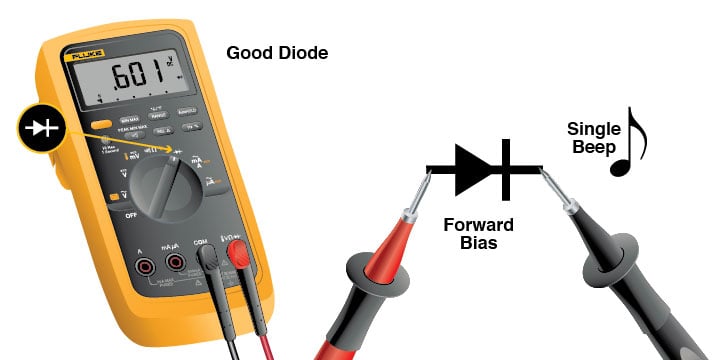
Applications of Diodes
- Power Conversion: Rectifiers convert AC signal into pulsing DC signal, making it easier to control the flow of power.
- Signal Demodulation: Demodulation diodes are a critical part of radio receivers. The diodes retrieve the original message sent through the airwaves for transmission.
- Overvoltage Protection: Zener diodes are used to protect circuits from unsafe voltage levels. They are also used to protect supply lines and power supply control lines.
- Logic Gates: Diodes play a crucial role in modern computing and digital technology. They make it possible to reinforce binary systems through gates that perform simple logic functions, like and/or/not.
Case Study: Using Diodes with the Fluke 87V Digital Multimeter
Scoreboards often use LEDs in connected series. When one diode fails, all or part of a segment often fails to light.
Solving this problem using legacy tools can be time-consuming: it means setting up a DC power source and resistor to test each LED individually.
Fortunately, the Fluke 87V Industrial Multimeter has a built-in diode test mode, so that technicians can identify the defective LED and fix the problem quickly. The process consists of just four steps:

- Verify that all power to the circuit is off and that all capacitors are discharged.
- Set the multimeter to measure either AC or DC voltage, as needed. Turn the dial to diode test mode.
- Connect the test leads to the diode and record the measurement displayed.
- Reverse the test leads and record the measurement displayed.
This test pinpoints exactly which diodes are causing the trouble.
Bad diodes, like the ones that brought down the scoreboard, stop current from flowing in both directions. The multimeter display will read OL for both steps three and four when measuring a bad diode.
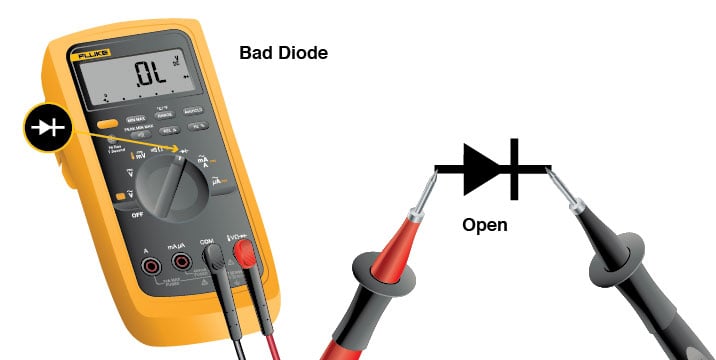
A shorted diode will have the same voltage reading in both directions (usually in the range of 0.4 volts).
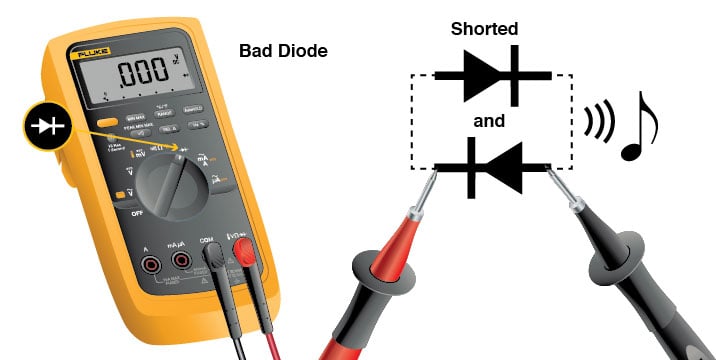
Once the faulty diodes are identified, a technician can simply replace them, and the scoreboard should work like normal again.
Final Thoughts
Though small and simple, the diode is an essential part of modern electrical systems. By controlling the flow and direction of current, diodes enable countless applications of modern electronics.
Fortunately, tools like digital multimeters make it easy to measure diode health and determine when it’s time to replace diodes. This allows technicians to keep circuits in good running order, powering the electrical systems we all rely on.




